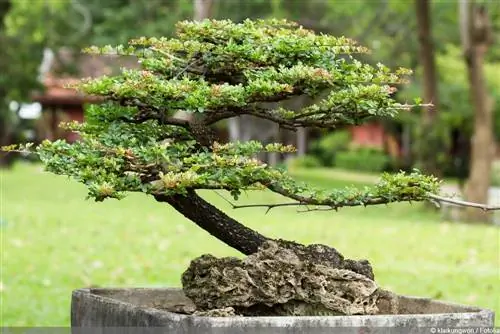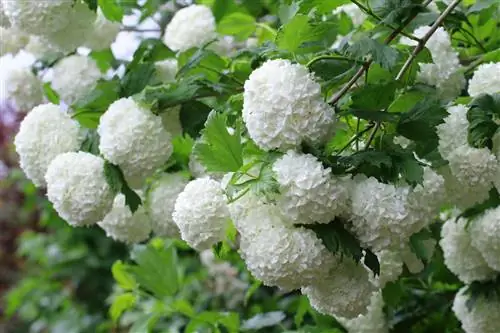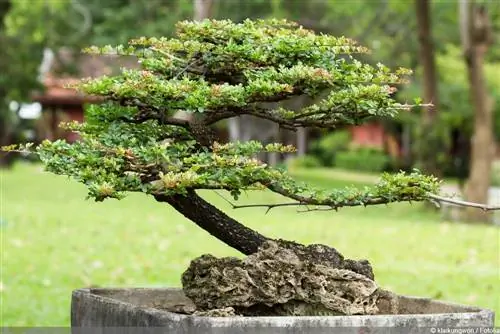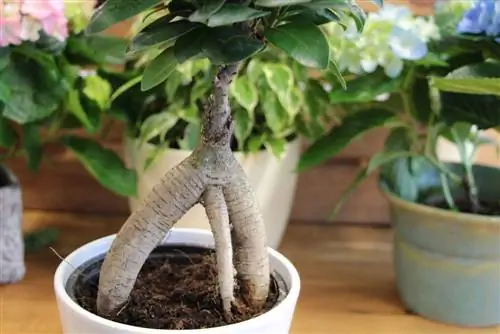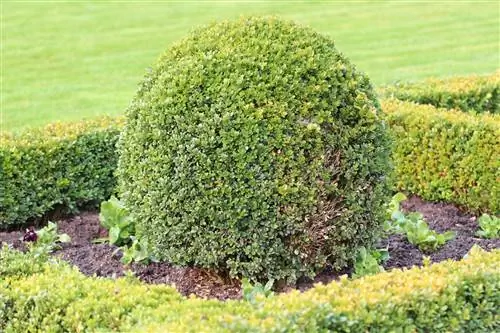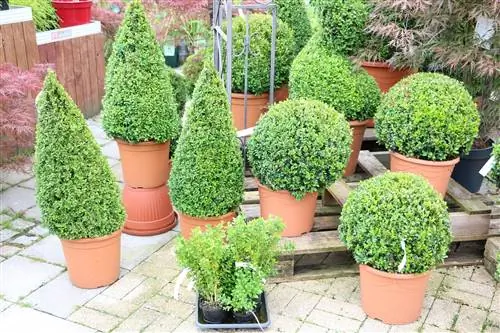- Author admin [email protected].
- Public 2023-12-17 03:39.
- Last modified 2025-01-24 12:45.
Bonsai plants are grown according to an ancient Chinese tradition that creates dwarf trees from normal trees. The trees can be shaped according to the ideas of their breeders. This requires, above all, regular shape cuts, which are also called design cuts. These restrict the growth of the trees and stimulate new growth in certain places in order to maintain a certain shape. In the following instructions we have put together the best way to proceed with topiary and what you should pay particular attention to.
Tool selection
For cutting, there are specially made bonsai cutting tools to avoid bruising the plants. A pair of pruning shears may be sufficient for the initial cut and will serve you well. For further regular topiary cuts, it is essential to work with bonsai tools. Most secateurs have blunt blades that are close together. They can crush a thick or hard branch. This can result in injuries and sometimes even loss of the branch. Bonsai scissors are suitable for fine roots, leaves and branches, while concave pliers are used for strong branches, especially on the trunk. These pliers leave a small indentation after the cut, which allows the cut to grow inconspicuously and quickly. However, all wounds are always treated with a wound healing agent, for example with a Japanese wound putty.
Tree growth
In general, trees strive to suppress the growth of side shoots in favor of main shoots located at the outer tips of the branches. This natural mechanism prevents the tree from being shaded by other trees. It is also responsible for natural height growth. As the growth shoot shifts to the tips of the trees, the lower and inner branches die over time and the upper branches develop disproportionately. This growth process is of course undesirable when growing bonsai! Pruning the tips of a bonsai plant slows down this process, thereby better shifting growth to the lower and inner buds.
Best time to cut
Before or after the growing season is the best time to trim your bonsai plants into shape. This topiary is normally carried out regularly at intervals of two years.
Cutting shape
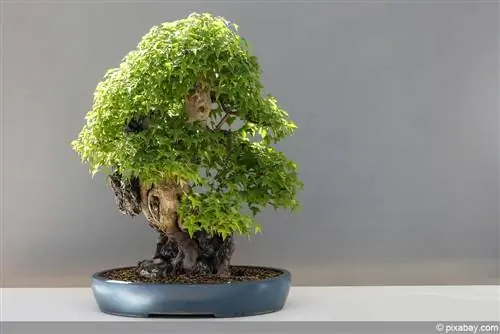
Before you start cutting, you should always have a specific goal and know what your bonsai should look like after cutting. You should follow this goal with every topiary. Depending on your goal, there may be corrections to different parts of the bonsai. Depending on the situation, cutting measures are carried out on the leaves, the branches or the trunk. The roots are only cut when repotting. For example, if you want to grow a tree sprout from your garden for bonsai, you first need to give it a basic shape and also remove large branches. Which branch you take away and which you keep is of course up to your imagination. However, right from the start you determine the appearance of the tree as a finished bonsai.
Tip:
When cutting, always place the tree at eye level and first remove withered branches and other dead plant parts. Look closely at your bonsai for some time and then follow your pruning goal for the selected topiary associated with the tree.
Basic rules for branches that are always removed
- vertically growing branches that can no longer be bent because they are already too strong
- if there are two branches that originate at the same height on the trunk, always remove one
- Branches crossing on the front of the trunk
- Branches with unnatural-looking curves and twists that cannot be bent in any other way
- disproportionately thick branches located near the top of the tree
Tip:
The branches at the bottom of the tree should always be thicker. Because they make the bonsai tree appear natural.
Rough classification of topiaries
The topiaries for coniferous and deciduous trees differ in many factors, if only because of their different leaf and bud structure. There are many bonsai shapes or styles, depending on the grower's taste, such as the cascade or double trunk shape. However, this also requires a certain understanding of the basic shape cuts for coniferous and deciduous trees.
Topiary pruning for conifers
In May and April
As soon as new candle-shaped shoots grow from the buds, cutting begins. Only the strongest shoot is removed in the middle so that the side candles can continue to grow. They should be in a balanced relationship to the other, weaker shoots.
Tip:
The weaker the shoot, the less it is shortened. Shoots up to 1 cm long must remain standing. If the drive is very strong, more of it is taken away. If shoots are too close, they are thinned out except for one or two. If you like, you can use your fingertips instead of scissors. The shoots can be easily twisted off.
End of June
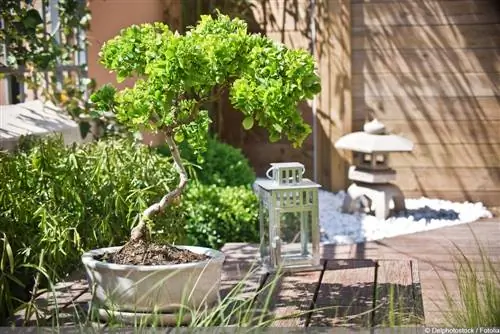
So that the needles stay nice and short, all shoots that have grown too long are cut back to 1 cm. On the remaining piece, new buds with shorter needles usually only form again after a year.
August and September
During this period, the needles from the previous year turn brown. You can simply slip these needles off with your fingers. If you are unable to do this, use the bonsai scissors and cut the needles back to the base. Now more light can enter, so that so-called sleeping eyes are stimulated to move out. However, if the buds are much too small and weak, it is better to leave the old needles on the plant. Needles that have just sprouted in spring are also left completely standing, usually four to five tufts of needles.
September to March
During this time, the areas that have become too dense will be thinned out. The buds that are not needed to build the mold are simply nipped out with tweezers by mid-November. The buds that appear interesting to you and that you believe will serve the desired shape goal remain.
Topiary pruning for deciduous trees
The bud position of the branches varies greatly among deciduous trees and is therefore divided into two basic main groups:
Alternate buds
For example, rubber tree, hornbeam, hawthorn and hornbeam have this type of buds. These bonsai trees are only allowed to sprout properly in spring and are only cut back to one or two leaves once they have developed five to six leaves. However, on bonsais that are still in the branch development phase, three leaves remain.
Tip:
For a more beautiful shape of deciduous tree bonsai, if possible, cut to a bud that is directed downwards.
Opposite buds
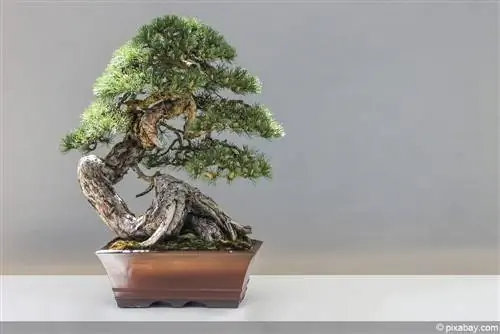
Privet, lilac and chestnut, for example, have opposite buds. These bonsai trees can also sprout beautifully in spring and are cut back to one to three leaves. A bud may always stick out in the wrong direction because there are two buds exactly opposite each other at the same height. Simply remove an unwanted bud if necessary.
General pruning methods for bonsais
- cut strong shoots diagonally above a bud (with bonsai scissors)
- cut weak shoots at right angles to the direction of growth above a bud (with bonsai scissors)
- Cut off branches on the trunk that should be completely removed directly on the trunk (with concave pliers)
Conclusion
Topiary pruning for bonsai seems very difficult at first. However, with each cut you will become more and more comfortable with shaping your bonsai. As soon as the bonsai has reached its final shape, you have to pluck out the shoots when opening the buds so that it stays in its shape. Scattered leaves that have become too large and internodes that are too long can simply be cut away over the course of the growing season. To find your own style, feel free to experiment as long as you follow the basic rules of bonsai cutting listed above.

